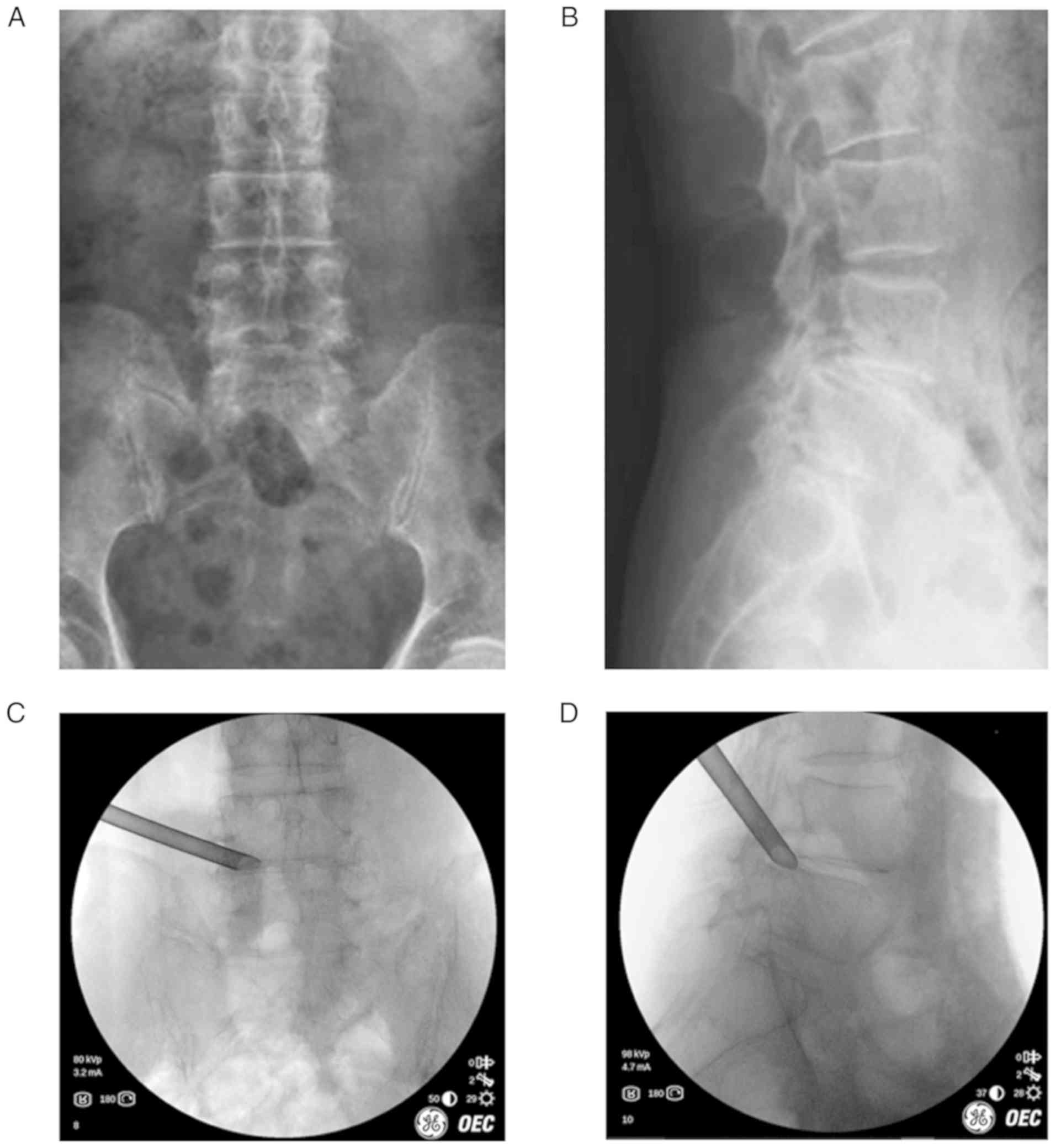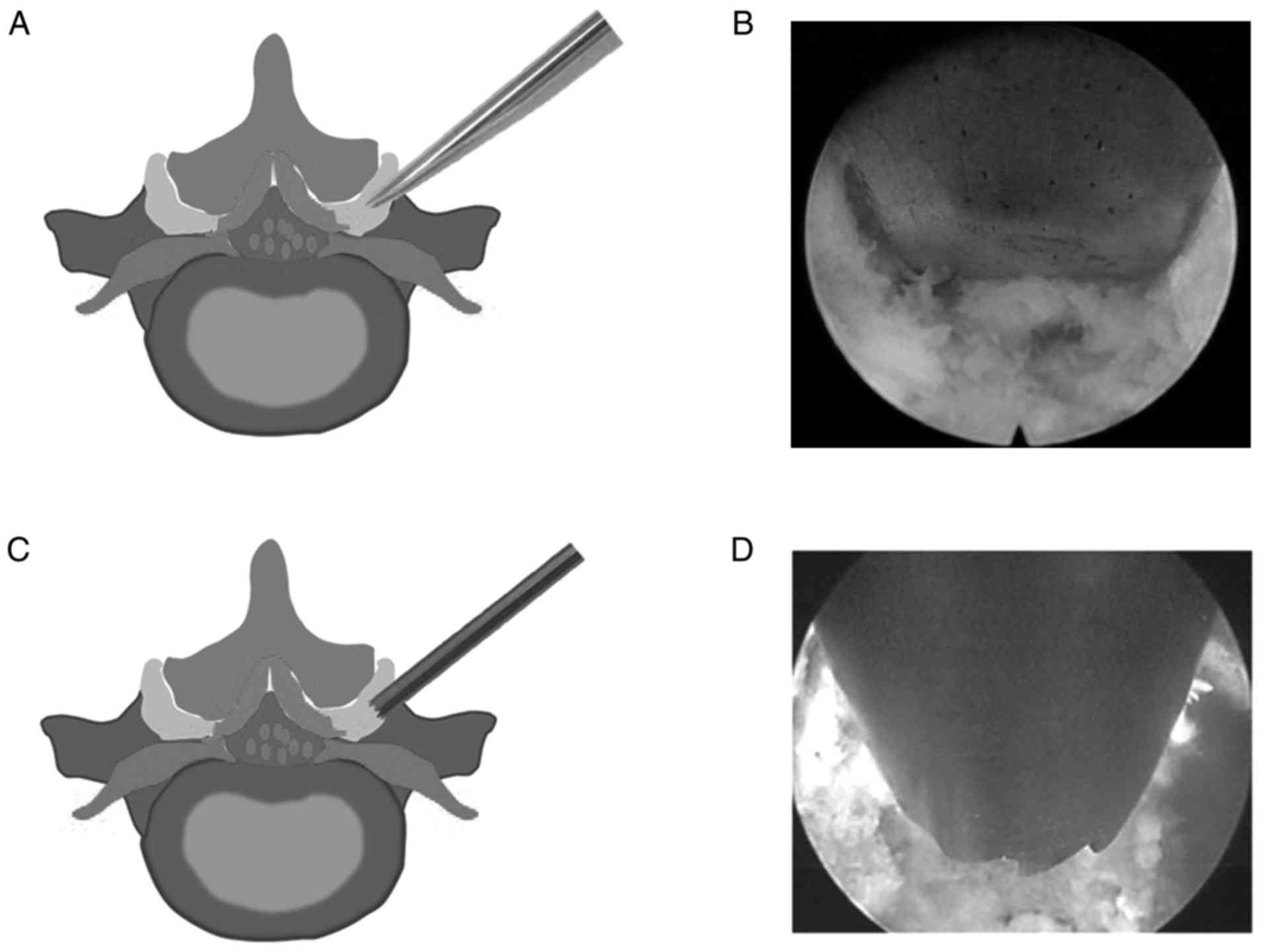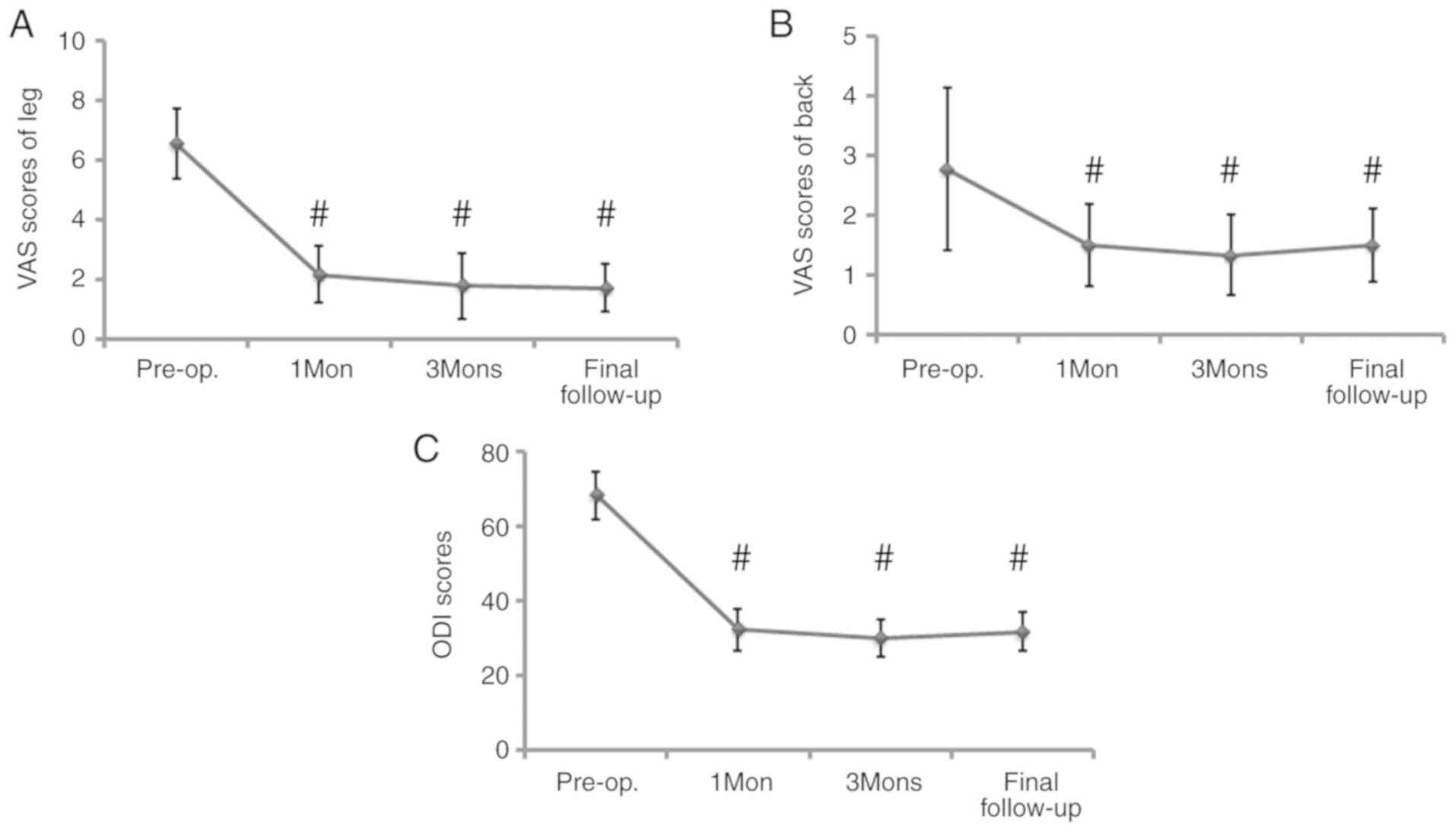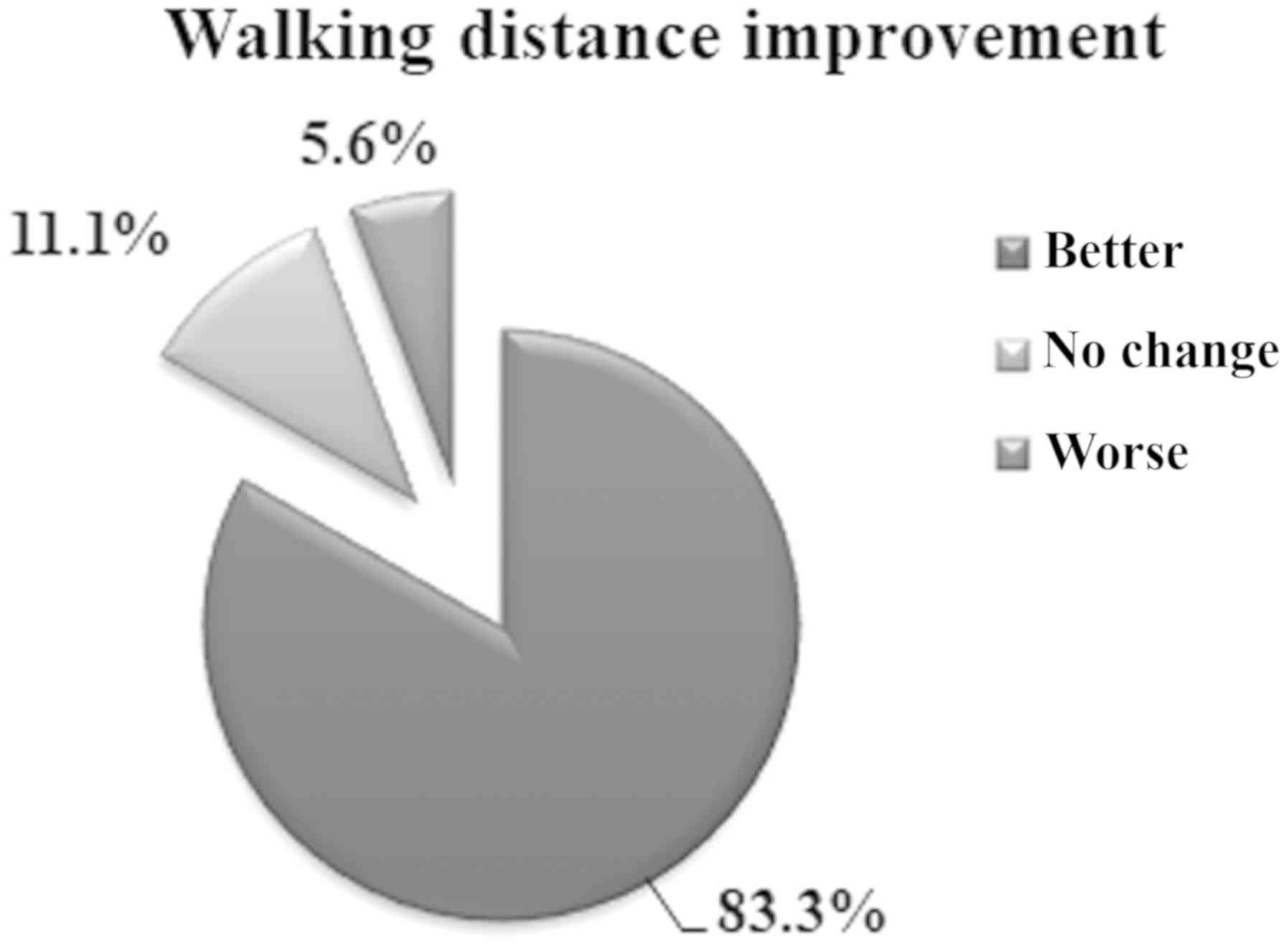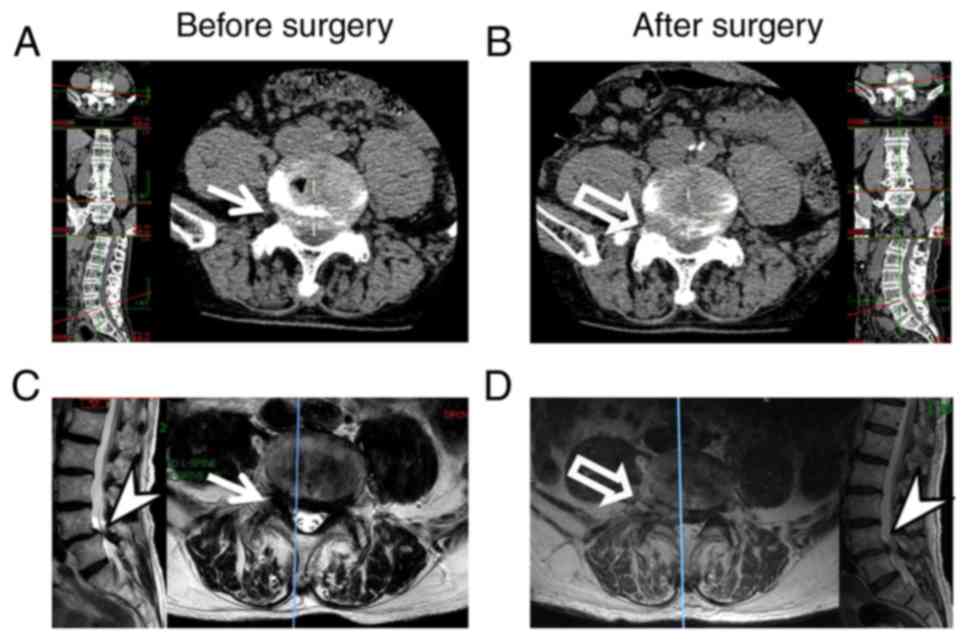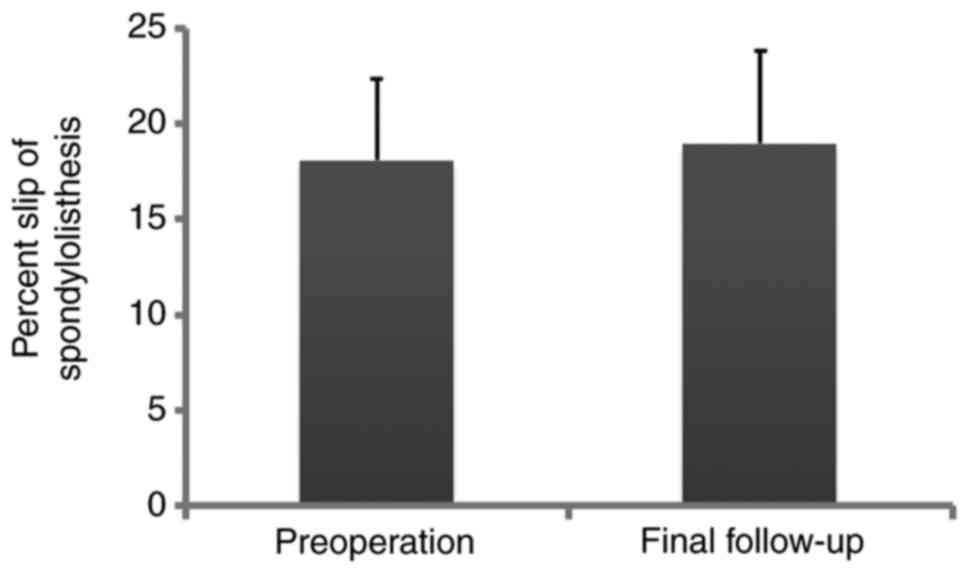|
1
|
Scholler K, Alimi M, Cong GT, Christos P
and Hartl R: Lumbar spinal stenosis associated with degenerative
lumbar spondylolisthesis: A systematic review and meta-analysis of
secondary fusion rates following open vs minimally invasive
decompression. Neurosurgery. 80:355–367. 2017. View Article : Google Scholar : PubMed/NCBI
|
|
2
|
Resnick DK, Watters WC III, Sharan A,
Mummaneni PV, Dailey AT, Wang JC, Choudhri TF, Eck J, Ghogawala Z,
Groff MW, et al: Guideline update for the performance of fusion
procedures for degenerative disease of the lumbar spine. Part 9:
Lumbar fusion for stenosis with spondylolisthesis. J Neurosurg
Spine. 21:54–61. 2014. View Article : Google Scholar : PubMed/NCBI
|
|
3
|
Austevoll IM, Gjestad R, Brox JI, Solberg
TK, Storheim K, Rekeland F, Hermansen E, Indrekvam K and Hellum C:
The effectiveness of decompression alone compared with additional
fusion for lumbar spinal stenosis with degenerative
spondylolisthesis: A pragmatic comparative non-inferiority
observational study from the norwegian registry for spine surgery.
Eur Spine J. 26:404–413. 2017. View Article : Google Scholar : PubMed/NCBI
|
|
4
|
Ghogawala Z, Dziura J, Butler WE, Dai F,
Terrin N, Magge SN, Coumans JV, Harrington JF, Amin-Hanjani S,
Schwartz JS, et al: Laminectomy plus fusion versus laminectomy
alone for lumbar spondylolisthesis. N Engl J Med. 374:1424–1434.
2016. View Article : Google Scholar : PubMed/NCBI
|
|
5
|
Ahmad S, Hamad A, Bhalla A, Turner S,
Balain B and Jaffray D: The outcome of decompression alone for
lumbar spinal stenosis with degenerative spondylolisthesis. Eur
Spine J. 26:414–419. 2017. View Article : Google Scholar : PubMed/NCBI
|
|
6
|
Inose H, Kato T, Yuasa M, Yamada T,
Maehara H, Hirai T, Yoshii T, Kawabata S and Okawa A: Comparison of
decompression, decompression plus fusion, and decompression plus
stabilization for degenerative spondylolisthesis: A prospective,
randomized study. Clin Spine surg. 31:E347–E352. 2018. View Article : Google Scholar : PubMed/NCBI
|
|
7
|
Chang W, Yuwen P, Zhu Y, Wei N, Feng C,
Zhang Y and Chen W: Effectiveness of decompression alone versus
decompression plus fusion for lumbar spinal stenosis: A systematic
review and meta-analysis. Arch Orthop Trauma Surg. 137:637–650.
2017. View Article : Google Scholar : PubMed/NCBI
|
|
8
|
Alimi M, Hofstetter CP, Pyo SY, Paulo D
and Hartl R: Minimally invasive laminectomy for lumbar spinal
stenosis in patients with and without preoperative
spondylolisthesis: Clinical outcome and reoperation rates. J
Neurosurg Spine. 22:339–352. 2015. View Article : Google Scholar : PubMed/NCBI
|
|
9
|
Minamide A, Yoshida M, Simpson AK,
Nakagawa Y, Iwasaki H, Tsutsui S, Takami M, Hashizume H, Yukawa Y
and Yamada H: Minimally invasive spinal decompression for
degenerative lumbar spondylolisthesis and stenosis maintains
stability and may avoid the need for fusion. Bone Joint J.
100-B:499–506. 2018. View Article : Google Scholar : PubMed/NCBI
|
|
10
|
Allen RT and Garfin SR: The economics of
minimally invasive spine surgery: The value perspective. Spine
(Phila Pa 1976). 35 (26 Suppl):S375–S382. 2010. View Article : Google Scholar : PubMed/NCBI
|
|
11
|
Liu X, Yuan S, Tian Y, Wang L, Gong L,
Zheng Y and Li J: Comparison of percutaneous endoscopic
transforaminal discectomy, microendoscopic discectomy, and
microdiscectomy for symptomatic lumbar disc herniation: Minimum
2-year follow-up results. J Neurosurg Spine. 28:317–325. 2018.
View Article : Google Scholar : PubMed/NCBI
|
|
12
|
Ahn Y, Oh HK, Kim H, Lee SH and Lee HN:
Percutaneous endoscopic lumbar foraminotomy: An advanced surgical
technique and clinical outcomes. Neurosurgery. 75:124–133,
Discussion 132–133. 2014. View Article : Google Scholar : PubMed/NCBI
|
|
13
|
Shin SH, Bae JS, Lee SH, Keum HJ, Kim HJ
and Jang WS: Transforaminal endoscopic decompression for lumbar
spinal stenosis: A novel surgical technique and clinical outcomes.
World Neurosurg. 114:e873–e882. 2018. View Article : Google Scholar : PubMed/NCBI
|
|
14
|
Li XF, Jin LY, Lv ZD, Su XJ, Wang K, Song
XX and Shen HX: Endoscopic ventral decompression for spinal
stenosis with degenerative spondylolisthesis by partially removing
posterosuperior margin underneath the slipping vertebral body:
Technical note and outcome evaluation. World Neurosurg.
126:e517–e525. 2019. View Article : Google Scholar : PubMed/NCBI
|
|
15
|
Downie WW, Leatham PA, Rhind VM, Pickup ME
and Wright V: The visual analogue scale in the assessment of grip
strength. Ann Rheum Dis. 37:382–384. 1978. View Article : Google Scholar : PubMed/NCBI
|
|
16
|
Daltroy LH, Cats-Baril WL, Katz JN, Fossel
AH and Liang MH: The North American spine society lumbar spine
outcome assessment Instrument: Reliability and validity tests.
Spine (Phila Pa 1976). 21:741–749. 1996. View Article : Google Scholar : PubMed/NCBI
|
|
17
|
Macnab I: Negative disc exploration. An
analysis of the causes of nerve-root involvement in sixty-eight
patients. J Bone Joint Surg Am. 53:891–903. 1971. View Article : Google Scholar : PubMed/NCBI
|
|
18
|
Jasper GP, Francisco GM and Telfeian AE:
Transforaminal endoscopic discectomy with foraminoplasty for the
treatment of spondylolisthesis. Pain Physician. 17:E703–E708.
2014.PubMed/NCBI
|
|
19
|
Jasper GP, Francisco GM, Aghion D and
Telfeian AE: Technical considerations in transforaminal endoscopic
discectomy with foraminoplasty for the treatment of
spondylolisthesis: Case report. Clin Neurol Neurosurg. 119:84–87.
2014. View Article : Google Scholar : PubMed/NCBI
|
|
20
|
Kim CH, Chung CK, Choi Y, Kim MJ, Kim MJ,
Shin S, Yang SH, Hwang SH, Kim DH, Park SB and Lee JH: increased
proportion of fusion surgery for degenerative lumbar
spondylolisthesis and changes in reoperation rate: A nationwide
cohort study with a minimum 5-year follow-Up. Spine (Phila Pa
1976). 44:346–354. 2019. View Article : Google Scholar : PubMed/NCBI
|
|
21
|
Hsieh MK, Kao FC, Chen WJ, Chen IJ and
Wang SF: The influence of spinopelvic parameters on
adjacent-segment degeneration after short spinal fusion for
degenerative spondylolisthesis. J Neurosurg Spine. 29:407–413.
2018. View Article : Google Scholar : PubMed/NCBI
|
|
22
|
Winter RB: The natural history of
spondylolysis and spondylolisthesis. J Bone Joint Surg Am.
67:8231985. View Article : Google Scholar : PubMed/NCBI
|
|
23
|
Zander T, Rohlmann A, Klockner C and
Bergmann G: Influence of graded facetectomy and laminectomy on
spinal biomechanics. Eur Spine J. 12:427–434. 2003. View Article : Google Scholar : PubMed/NCBI
|
|
24
|
Ikuta K, Tono O and Oga M: Clinical
outcome of microendoscopic posterior decompression for spinal
stenosis associated with degenerative spondylolisthesis-minimum
2-year outcome of 37 patients. Minim Invasive Neurosurg.
51:267–271. 2008. View Article : Google Scholar : PubMed/NCBI
|
|
25
|
Jang JW, Park JH, Hyun SJ and Rhim SC:
Clinical outcomes and radiologic changes after microsurgical
bilateral decompression by a unilateral approach in patients with
lumbar spinal stenosis and grade I degenerative spondylolisthesis
with a minimum 3-year follow-up. Clin Spine Surg. 29:268–271. 2016.
View Article : Google Scholar : PubMed/NCBI
|
|
26
|
Kelleher MO, Timlin M, Persaud O and
Rampersaud YR: Success and failure of minimally invasive
decompression for focal lumbar spinal stenosis in patients with and
without deformity. Spine (Phila Pa 1976). 35:E981–E987. 2010.
View Article : Google Scholar : PubMed/NCBI
|
|
27
|
Dijkerman ML, Overdevest GM, Moojen WA and
Vleggeert-Lankamp CLA: Decompression with or without concomitant
fusion in lumbar stenosis due to degenerative spondylolisthesis: A
systematic review. Eur Spine J. 27:1629–1643. 2018. View Article : Google Scholar : PubMed/NCBI
|
|
28
|
Chen Z, Zhang L, Dong J, Xie P, Liu B,
Wang Q, Chen R, Feng F, Yang B, Shu T, et al: Percutaneous
transforaminal endoscopic discectomy compared with microendoscopic
discectomy for lumbar disc herniation: 1-year results of an ongoing
randomized controlled trial. J Neurosurg Spine. 28:300–310. 2018.
View Article : Google Scholar : PubMed/NCBI
|
|
29
|
Forsth P, Michaelsson K and Sanden B: Does
fusion improve the outcome after decompressive surgery for lumbar
spinal stenosis?: A two-year follow-up study involving 5390
patients. Bone Joint J. 95-B:960–965. 2013. View Article : Google Scholar : PubMed/NCBI
|
|
30
|
Ruetten S, Komp M and Godolias G: A New
full-endoscopic technique for the interlaminar operation of lumbar
disc herniations using 6-mm endoscopes: Prospective 2-year results
of 331 patients. Minim Invasive Neurosurg. 49:80–87. 2006.
View Article : Google Scholar : PubMed/NCBI
|
|
31
|
Nie H, Zeng J, Song Y, Chen G, Wang X, Li
Z, Jiang H and Kong Q: Percutaneous endoscopic lumbar discectomy
for L5-S1 disc herniation via an interlaminar approach versus a
transforaminal approach: A prospective randomized controlled study
with 2-year follow up. Spine (Phila Pa 1976). 41 (Suppl
19):B30–B37. 2016. View Article : Google Scholar : PubMed/NCBI
|















